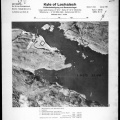Luftwaffe over Scotland
This feature highlights a selection of the aerial photographs of Scotland taken by the German Luftwaffe during the Second World War. German aerial reconnaissance of Scotland was first carried out in 1938, when concealed cameras were mounted in civilian Lufthansa aircraft which ranged across Europe, from Ireland to the Baltic, under the guise of checking potential air routes. During the Second World War, various types of German reconnaissance aircraft overflew Scotland from bases in Norway and Denmark, with collection rates declining from 1943 onward, as defending fighters attained greater performance and German priorities changed following the cancellation of plans to invade Britain.
The images featured here are some of the target graphics created from the original reconnaissance photographs - they have been cropped and annotated with intelligence information by German photographic interpreters and were recovered from various locations across Europe in the last days of the war.
Download the Catalogue of Luftwaffe Photographs in the National Monuments Record of Scotland (RCAHMS 1999)














